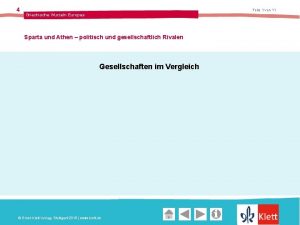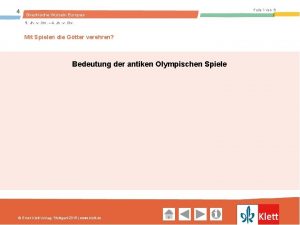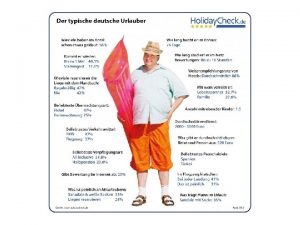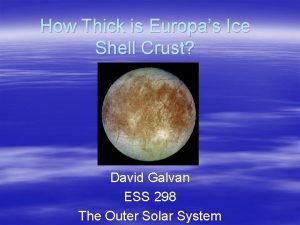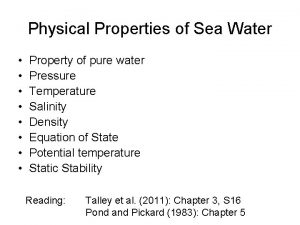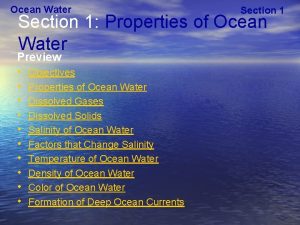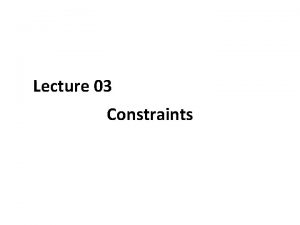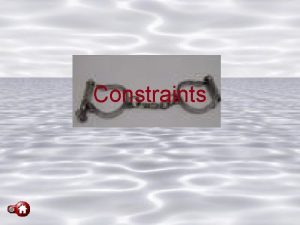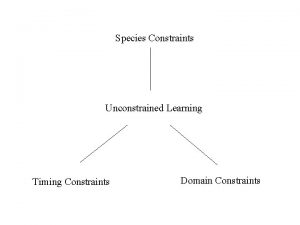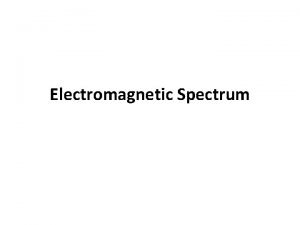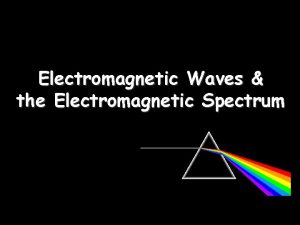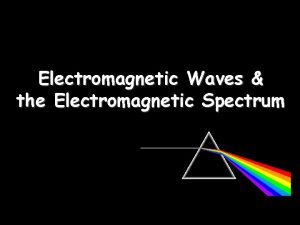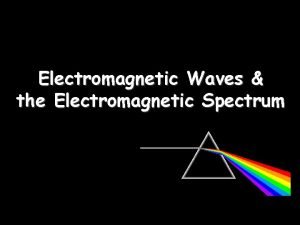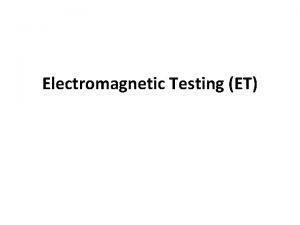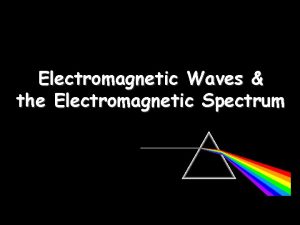Constraints on Europas ocean properties from multifrequency electromagnetic


















- Slides: 18

Constraints on Europa’s ocean properties from multi-frequency electromagnetic induction Krishan Khurana, Margaret Kivelson Dept. of Earth, Planetary and Space Science University of California at Los Angeles

The principle behind electromagnetic induction Eddy currents BInduced(t) BPrimary(t) The primary (external) and secondary fields shown separately The total field • The induced electric field generates Eddy currents on the surface of the conducting ocean. Eddy currents generate a secondary or induced field which reduces the primary (external) field inside the conductor. • The induced field can be inferred from magnetometer observation. • This induction can help us find the ice and ocean thicknesses of Europa. 2

Jupiter provides the primary field • Europa is located in the inner magnetosphere of Jupiter where the background field is ~ 500 n. T. • Because the dipole and rotation axes of Jupiter are not aligned, as Jupiter rotates, Europa experiences a varying field in its frame. • The figure on the right shows the varying field at Europa from one Jovian rotation in a coordinate system which has its x-axis directed along the orbit of Europa and y-axis pointing to Jupiter. 3

In Europa’s rest frame, the external field from Jupiter has many discrete frequencies that can be exploited for multi-frequency induction sounding. 4

Induction from a finite-conductivity shell 5

Our knowledge about Europa’s ocean from Galileo �E 4 and E 14 passes showed signatures consistent with induced dipolar fields from currents flowing near the surface. The direction of the dipole moment was directed towards Europa in both cases (as expected). �A subsequent pass (E 26) confirmed that the dipole moment flipped in response to the different orientation of Jupiter’s field as expected from theory. Khurana et al. Nature, 1998 E 14 6

Observed induction dipole moment observed Kivelson et al. , Science, 2000 Induction dipole moment from several Galileo passes plotted against predictions from a highly conducing ocean shell model. 7

Determining ice shell thickness The signal at shorter periods (11 hrs and shorter) can be inverted to obtain the thickness of ice layer. Hand Chyba, 2007 used the 11 hr period to show that the observations place only a lower bound on ice thickness (thickness > 10 km).

Our current knowledge of ice-shell thickness • • • The landmark study that synthesized the evidence for Europa’s ocean was by Pappalardo et al. (1999). Billings and Kattenhorn (2005) have updated that work and list ~ 50 studies on Europa’s ice shell thickness which use techniques as diverse as flexure analysis, Buoyancy analysis of rafted blocks, crater morphologies and thermal equilibrium modeling. The thickness estimates range from as low as 100 m to 38 km. No consensus. The largest thickness estimates arise from thermal analysis (10 -38 km), intermediates thicknesses come from impact studies (2. 4 – 29 km) and the thinnest estimates are from studies of flexures (100 m – 10 km). Galileo magnetometer data unambiguously confirm the presence of a liquid water ocean but are not robust enough to put reliable constraints on ice thickness, ocean thickness and ocean salinity. 9/16/2021 9

Our current knowledge of ice-shell thickness… continued Schematic visualization of Europa’s crust and its subsurface ocean Moore et al. 2009, Europa book 9/16/2021 10

Our current knowledge of ocean thickness • • • The thickness of the H 2 O layer is obtained from models of internal structure that rely on three parameters, Radius of Europa, total mass of Europa and its normalized moment of inertia (e. g. Anderson, Schubert et al. 1998) Most models suggest that the H 2 O layer is between 100 -150 km thick. Upper limit on heat flow measurements (20 m. W/m 2) suggest that the ice crust is ~ 30 km thick. Thus, the ocean thickness must be between 70 -120 km. Magnetic induction observed at the rotation period of Jupiter only place a lower limit of > 10 km on the ocean thickness. 11 Hussmann et al. 2002

How can an orbiter improve upon Galileo and Europa Clipper results? • As already discussed, Galileo observations from five usable flybys are extremely limited. • However, 40+ flybys of Europa Clipper allows multi-frequency electromagnetic induction to be performed. Galileo had provided information only at the synodic rotation frequency of Jupiter. • Higher frequencies (synodic rotation frequency and higher) are primarily sensitive to ice thickness. • Lower frequencies are also sensitive to ocean properties (ocean conductivity and thickness). • A Europa orbiter would allow us to use the broadband power in the spectrum to perform induction at a large number of wave periods. Long wave periods are especially useful for obtaining ocean thickness and salinity.

Europa Clipper will use signals at 11 and 85 hr periods to determine the ocean thickness and salinity. Contours of induced field (in n. T) generated at the surface in response to the 11. 2–hr (blue, solid lines) and 85. 2–hr waves (red, dashed lines) show that responses at these frequencies can uniquely determine ocean parameters in the regime where the contours intersect (in a small parameter range). 13

Europa clipper will provide estimate of ice thickness from response at synodic period (11. 2 hr) 14

An orbiter can exploit broad-band power that exists in the background (with an integrated power of ~ 150 n. T 2) to sense Europa’s ocean and deep interior. 15

Multi-frequency induction inversion from magnetometer data from an orbiter • The plasma interaction contribution is determined from global MHD models of Europa/magnetosphere interaction. • Once the contribution from the plasma interaction is subtracted, the magnetic field can be separated using Gauss’s method into external and internal contributions according to • where the complex coefficients nm ( l) and nm ( l ) represent the internal and external parts of the field. Both are functions of the inducing frequencies l and are related to the real coefficients by nm = gnm - i hnm and nm = Gnm - i Hnm. Ynm are the complex spherical harmonics, , and r are the azimuth, longitude and radial distance in spherical coordinates, R the reference surface, here the radius of Europa, and Re the real part of the expression. 9/16/2021 16

• Because of limited data, Europa clipper will use periods only up to 85. 2 hrs for induction studies. • A Europa orbiter can use much longer periods (several weeks) that penetrate deeper into Europa’s ocean and are not saturated in response with respect to ocean thickness. 17

Conclusions • Galileo magnetometer data unambiguously confirm the presence of a liquid water ocean but are not robust enough to put reliable constraints on ice thickness, ocean thickness and ocean salinity. • Europa Clipper mission would provide estimates of response at both the 11 hr and the 85 hour waves. • For a certain range of ocean thickness and conductivity (both large), the ocean thickness and the conductivity, Europa Clipper may provide unique values of ocean thickness and conductivity. • Thus Europa Clipper would further improve upon our knowledge of what we learned from Galileo. • However, a Europa Orbiter can provide estimates of signal strength and response at a much broader range of frequencies. • Europa Orbiter would be able to provide unique and accurate estimates of ice thickness, ocean thickness and its conductivity.
 Griechische wurzeln europas
Griechische wurzeln europas Deutschlands geographische lage
Deutschlands geographische lage Griechische wurzeln europas
Griechische wurzeln europas Griechische wurzeln europas
Griechische wurzeln europas Wie heißen die 47 länder europas
Wie heißen die 47 länder europas Reiseland deutschland - vielfalt im herzen europas
Reiseland deutschland - vielfalt im herzen europas Klett griechische götter
Klett griechische götter How thick is europas ice
How thick is europas ice Ocean ocean convergent boundary
Ocean ocean convergent boundary Ocean to ocean convergent boundary
Ocean to ocean convergent boundary Convergent plate boundaries
Convergent plate boundaries Red ocean strategi
Red ocean strategi Ocean to ocean convergent boundary
Ocean to ocean convergent boundary Ocean ocean convergent boundary
Ocean ocean convergent boundary Divergent plate boundary
Divergent plate boundary Nekton include all animals that
Nekton include all animals that Characteristics of pure water
Characteristics of pure water Ocean water properties
Ocean water properties Intensive property and extensive properties
Intensive property and extensive properties


